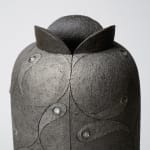Asano Masaru 浅野勝
H40.6 x Dia10.6 cm
Further images
-
(View a larger image of thumbnail 1
)

-
(View a larger image of thumbnail 2
)

-
(View a larger image of thumbnail 3
)

-
(View a larger image of thumbnail 4
)

-
(View a larger image of thumbnail 5
)

-
(View a larger image of thumbnail 6
)

-
(View a larger image of thumbnail 7
)

-
(View a larger image of thumbnail 8
)

-
(View a larger image of thumbnail 9
)

-
(View a larger image of thumbnail 10
)

-
(View a larger image of thumbnail 11
)

-
(View a larger image of thumbnail 12
)

-
(View a larger image of thumbnail 13
)

-
(View a larger image of thumbnail 14
)

The foundation of Asano Masaru (b. 1944)’s ceramic practice is rooted in the formative experiences of his youth. He became inspired by the ceramic genius of Kamoda Shōji, drawn to the intricate surface designs and poetic qualities of his work. During his early years, Asano moved to Tokyo, where he worked at a trading company in Kyobashi while residing in Shinbashi. After work, he often wandered through the Ginza district, exploring its many shops.
"I listened to a passionate discussion about pottery by a Korean-born colleague at work, who also introduced me to the antique district of Aoyama. I am indebted to him for guiding me through the unique characteristics of Mashiko pottery."
During one of his visits to Mashiko, Asano happened to stop by Shōji Hamada’s studio, where he encountered a display of Bizen ware. However, it was later—upon seeing Kamoda’s ceramics at a folk craft store—that his appreciation for functional pottery deepened. He was especially drawn to Kamoda’s mastery of surface treatment. Eager to absorb something from the artist’s creative world, Asano moved to Tōno City in Iwate Prefecture, where Kamoda had been working, and spent a year immersing himself in the region’s pottery traditions. Ultimately, he relocated his family from Mashiko to Tōno.
Deeply inspired by the city and its poetic heritage, he reflects, "I don’t think I would have been able to come up with this idea if I had stayed in Mashiko.”
Asano’s pottery studio is nestled in the mountains, overlooking a dam lake. He prefers the “iron-rich, rough soil” found near his workshop, as much of the clay’s minerality is drawn from the lake itself. His glazes primarily consist of ash glaze, iron glazes, and various metallic finishes. For ash glaze, he gathers wood from the surrounding mountains and fields. His firing method employs strong reduction carbonization, with raw firewood added in the final stage. The abstract surface patterns on his ceramics—marked by geometric forms and layers of ferric oxide red and subtle silver tones—create a striking visual effect.
There is a common belief that gold and silver patterns do not complement each other. "I think there are still some people who think negatively," he acknowledges. Yet, Asano’s work is defined by his willingness to challenge conventions and seek harmony in unexpected pairings. Even the iron content in soil, often seen as a nuisance and impurity by some artists, fascinates him. "Iron covers the surface of the earth. It is a substance essential to human life. That is what makes it interesting."
This unconventional perspective has allowed Asano to evolve his style with each exhibition. Some of his ceramics feature polyhedral surface structures, showcasing his refined technical skills. Yet, despite his constant innovation, he grapples with what he calls an "innate worry." In his pursuit of new creative frontiers, Asano continues to look inward—deep in the mountains of Iwate—seeking answers to the ever-present challenge of artistic evolution.
Artist CV
1944 Born in Miyagi Prefecture
1967 Studied under Daiguji Takahito in Mashiko
1973 Built a kiln in the same town
1976 First solo exhibition at Seibu Department Store Ikebukuro
1988 Built a kiln in Towa Town, Iwate Prefecture
Other solo exhibitions include Minamiaoyama Green Gallery in Tokyo and Yorozutetsugoro Memorial Museum in Towa Town, Iwate Prefecture.
Selected for the Traditional Crafts New Works Exhibition
Selected for Japanese Traditional Crafts Exhibition
Selected for Japanese Ceramic Art Exhibition













